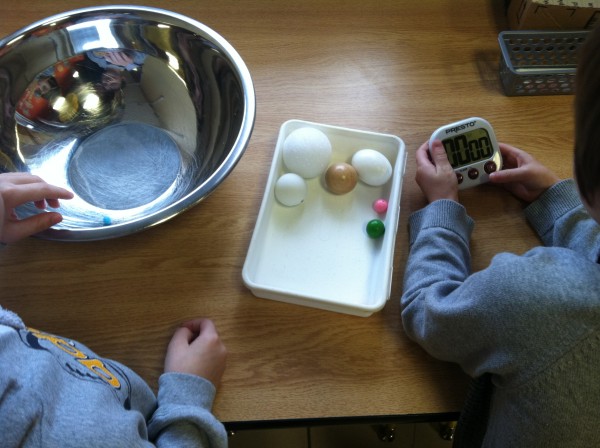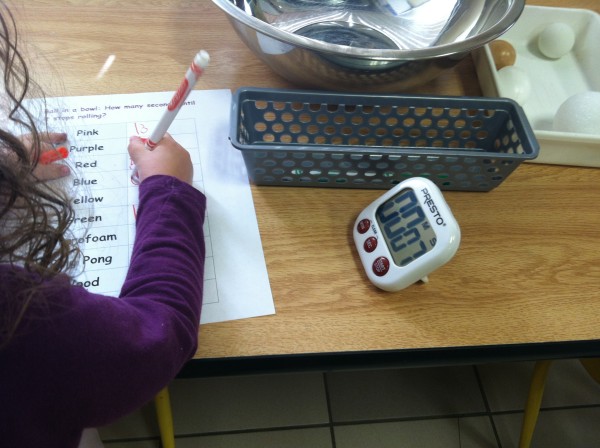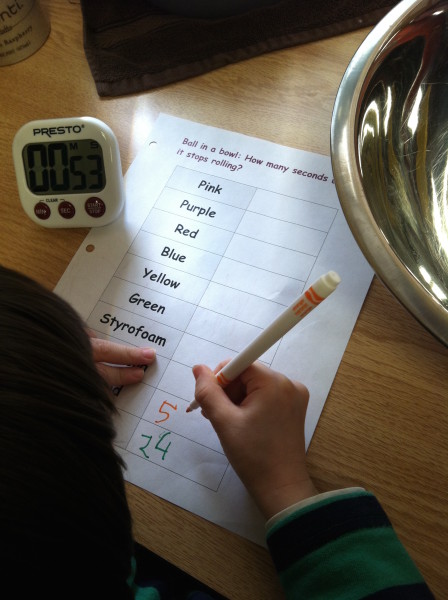My class recently ran a peculiar experiment, centered on the following question: “Which type of ball will roll for the longest time after it’s dropped into a bowl?” My goal was to set up a simple, engaging activity that would give my students an opportunity to practice measuring time.
The Setup
For materials, I used a metal bowl and an assortment of spherical objects. I tried to gather objects of different sizes and materials, although I didn’t expect we would ultimately be able to make any convincing conclusions regarding what makes a ball roll longest.
Teaching my students to use a timer was somewhat challenging. We used a timer that shows whole seconds, without decimal points. However, it was still hard to read. The screen has extra zeros (e.g., 5 seconds looks like 0005), which often confused students. Also, the numbers are digital block numbers, which my students are largely unfamiliar with. The digital fives and twos were particularly difficult to distinguish, as they mirror each other—such reversals are very typical for young children.
Nevertheless, after a brief tutorial, all of my students were able to use the timer independently. They occasionally forgot what each button does, or misread “0003” as thirty, but they needed only brief assistance to get back on track.
Math Concepts
I introduced our timer by explaining that it measures seconds. When we press the start button, it starts counting upwards—one more number every time another second passes. A ball that rolls for just three seconds stops pretty quickly. But when a ball rolls for forty seconds, it takes a lot of time for that many seconds to pass.
Working with numbers in this way, albeit somewhat abstract, has some advantages. For one thing, it’s less passive than presenting a group of objects or some physical characteristics as associated with a particular number. With the timer, the numbers change, which is engaging and has new meaning.
Another advantage is that the progression of time naturally gives children a new way to conceptualize the relationship between numbers. As the timer counts up, they see increasingly larger umbers. They can watch as eight follows seven—it took longer to get to eight, so eight is clearly more seconds. I can’t say with any certainty that familiarity with such a context helps children compare numbers, but my hunch is that it does.
The Response
I was unsure how captivating this experiment would be. The question we were trying to answer wasn’t particularly exciting. If disinterest had settled in after a couple of days, I would have moved on, satisfied that we had learned how to use a timer (which has benefited us in subsequent experiments).
But to my delight, everyone loved it. The science center was constantly occupied, and children worked very cooperatively—usually, one student operated the timer while another released the balls. I took the opportunity to extend the lesson by introducing a chart for recording observations.
When I committed to expanding my science center this year, I knew that it would be difficult to consistently prepare experiments that students are capable of carrying out independently. Some of my efforts have misfired, while others have been successful. When it works, it’s often because children have plenty to do and plenty of options. Measuring time seems to meet those requirements. It’s an enthralling way to enhance early science and mathematics concepts.



Pingback: Spinning Tops: Integrating Math and Science - Joe Robinson